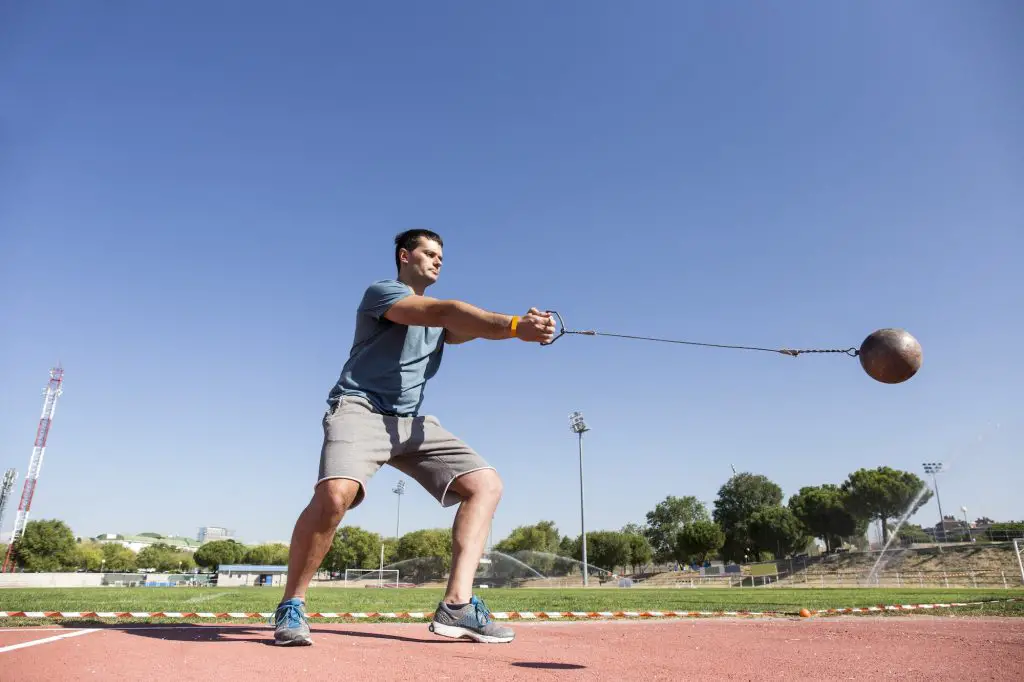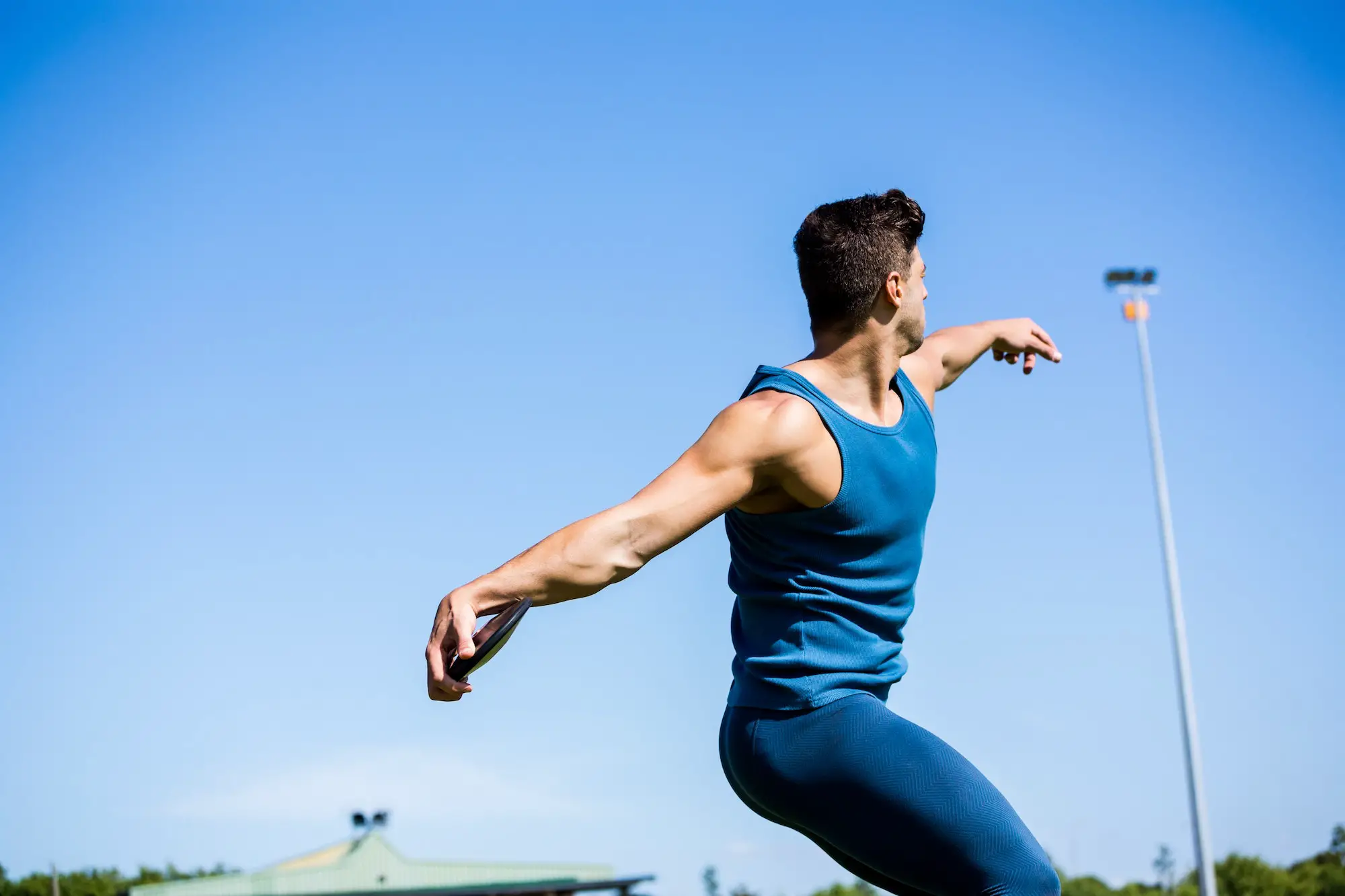In this article, we interviewed Joanna Waite. Joanna is a track & field coach at the junior division level for three years and a throwing athlete for just under a decade. She has seen athletes go through the process of finding the right event for them.
Throwing is a unique realm of the track because its success is not as dependent on body type as most other track events often are. Becoming a successful thrower, like most other things, is all about repetition, repetition, repetition.
What is the most popular throwing event in track and field?
The 4 main throwing events in track and field are Discus, Shotput, Hammer, and Javelin. Among these 4 throwing events, Discus and Javelin are considered the most popular throwing events in track and field.
- Hammer, Discus, and Shotput all take place within a leveled cement Circle with boarders surrounding it. People refer to this as the circle.
- Specific to individual events are techniques such as Blocking when the thrower has Braced or Blocked themselves following a throw resulting in the immediate halt of their movements to avoid stepping over the line or circle.
- Spinning, Glides or Shuffles for the circle throws are different techniques to build momentum for your throw.
Each throwing event, while they maintain certain similarities, is often much different from each other than most people starting out might realize.
Typically the weight goes up per year if you begin in the junior division, then stays the same from junior adult level until you reach age 50+ where it starts to diminish again.
Shot Put
| Age | Shot Put Weight |
| Men ages 12-16 | 3kg-5kg |
| Men ages 17-50 | 6kg-7.25kg |
| Women ages 12-16 | 2.75kg-3kg |
| Women ages 17-50 | 4kg |
This event consists of the thrower tucking a large metal ball (the shotput) under their chin with their dominant hand. Elbow up high and facing the opposite direction of where you want to throw, towards the back of the circle.
Bent low to begin, the thrower will twist their body while pushing their legs up and using a pushing motion rather than a throwing one一launch the shot put into the air.
Shot put is a less glamorized throwing sport. Fewer people will do spins or even glides when first starting out, the distances are often very short compared to the other throwing events.
Shotput is unique due to its total focus on the strength you put behind the throw.
Oftentimes, a successful shotput thrower is going to be large; you need powerful legs and arms to be able to launch the shotput as far as possible.
To improve in shotput will take more power training, building strength in your legs, as well as time in the circle. Build your way up with the techniques you use, starting with a Standing Throw and moving up to the Shuffle, Glide, or Spin depending on which works best for you.
Hammer Throw
| Age | Hammer Weight |
| Men ages 12-16 | 3kg-5kg |
| Men ages 17-50 | 6kg-7.25kg |
| Women ages 12-16 | 3kg |
| Women ages 17-50 | 4kg |
To throw the hammer start in a standing position. You should be facing the back of the circle with your feet a few inches away from the edge of the front, and slightly more than shoulder width apart.
Cupping your hands, wrap your non-dominant hand around the handle of the hammer with your other hand on top. Never interlace your fingers as you want them to be able to open up easily for a smooth release.
Starting with the hammer on the ground, lift it and start swinging it around your head gaining momentum, while maintaining a low stance.
After you have built enough momentum (roughly three swings around your head, any more will tire you out) twist on your left heel and your right toe. Pushing up with your legs snap your hips around first, then your shoulders followed by your arms, and release the hammer as your body faces forward toward the field.
Hammer is often one of the more intimidating throwing sports, to begin with. You need to have incredible control as the weight of the ball, and its momentum is enough to throw even the largest throwers off balance and out of the circle.
To improve, start with core exercises as this will help with your overall balance in the circle, then practice with your standing throw, as described above. Once comfortable with that move on to one spin, then two, three, or even four spins as this will build more momentum.
While most people think a hammer is exclusive to powerful and large body types; really all you need is balance and control to excel in this event. The ability to control your throw even when doing spins is the key to success in hammer.
Discus
| Age | Discus Weight |
| Men ages 12-16 | 1kg-1.5kg |
| Men ages 17-50 | 1.75kg-2kg |
| Women ages 12-16 | 0.75-1kg |
| Women ages 17-50 | 1kg |
To begin at discus, start with a standing throw. Hold the discus flat in your palm with your fingers reaching just over the edge.
Face sideways in the circle so that your dominant hand is on your back leg. With your other foot snug against the edge of the circle spread your feet just over shoulders distance apart, swing your arm behind you with your palm facing up bending onto your back leg.
Push up on your leg, your hip twisting first, then shoulder, then arm, twisting your arm so your palm is now facing down.
Make a slight squeezing motion with your fingers as you release the discuss in front of you to ensure a flat release.
Discus is an event where there are a few different techniques you can use to improve your skills.
Excellent balance and coordination are important in this sport as it involves a lot of spinning. Start with the standing throw, then a Step-In Spin, then one or two spins in the circle.
This event is typically suited for everyone. With a very good median between the slower paced shotput and the high-spin ratio of hammer, all body types can be successful in this event.
Javelin
| Age | Javelin Weight |
| Men ages 12-16 | 400g-700g |
| Men ages 17-50 | 700g-800g |
| Women ages 12-16 | 400g-500g |
| Women ages 17-50 | 500g-600g |
Hold the javelin in your palm with fingers wrapped around it, index extended along its length for support, and your wrist extended backwards.
Pull your shoulder back, arm straight, so that the javelin rests across your arm, and point your non-dominant arm in the direction you want it to go.
With the same stance as in discus, bend your back leg low then push up, thrusting your hip, then bringing your arm over your head and releasing the javelin. The motion is similar to throwing a baseball.
Javelin is the only throwing sport that requires a double edged training approach.
To move forward and be successful in javelin you also need to be a powerful sprinter. The higher levels of javelin have a run-up, compared to the spins of other throwing events.
This sets javelin apart from the others in the technique and training you need to practice. Often the most successful people in javelin also participate in sprints, though this isn’t always the case.
Choosing Event That is Right for You

While all of these throwing events attract many participants, often the most popular ones are discus and javelin.
Discus offers an appealing middle ground to shotput and hammer. The spins are often wider, and more graceful than their powerful counterparts, and the weight of the discus is less intimidating for beginners.
Javelin, on the other hand, is popular due to its interchangeability with sprinting. If you have been a sprinter or runner for a long time, this might be the event to get you started in throwing with some success right away.
Shotput and hammer are typically less popular due to the necessity of control and power for both events.
Particularly with hammer, the intimidating factor of the spins while swinging around a metal ball often puts people off when they first start.
They are both a bit more technically difficult which makes them less appealing to those starting throwing.
Deciding which throwing event is right for you is entirely dependent on your previous experience with track events, whether or not you prefer running, and whether you would prefer using power over speed.
The best introductory throwing events are shotput and discus, which can be taught to the youngest members of the junior division track.
Hammer and javelin, for safety reasons, are often left to be taught after a young member has gained some coordination and confidence in their throwing abilities.
To really excel in throwing, requires a lot of repetition training. Practice your spins or throwing motion at home, in socks on a smooth surface.
Most practice sessions become too tiring after about 30 minutes, so make sure you practice efficiently, thinking about technique and control. Repetition is key to becoming successful at these events, as well as strength training, and balance.
However, every thrower experiences a moment when they finally click into their ability to use their full power. Keep practicing technique until it becomes second nature and that’s when you can turn your mind off and really let your throws fly.
Recommended Shoes By Skill Levels
Before you start your search for the right throwing shoe, it’s important that you identify the most important factors that will affect your purchase. Below are the types of throwing shoes for different events:
- Dicus: Flat, rubber-soled throwing shoes
- Shotput: Throwing shoes
- Hammer: Throwing shoes, and a leather throwing glove
- Javelin: Sprinting spikes
Before you buy a new shoe, make sure that you get training in order to improve your skills. One of the best places to start is Amazon, as they have the best selection of throwing shoes.
On average, it’s recommended to practice at least 3 days a week to improve your throwing.
Beginners
[amazon box=”B00XXEVZLI”]
For people who are new to throwing, the best shoe is the ASICS Men’s Throw Pro Track Shoe. This is because it will allow you to start with a beginner level and throw anything that’s less than 35 feet. However, this shouldn’t be a harsh categorization.
At most meets, people are just chucking around and not trying to throw far. In order to improve your skills, you must always be dedicated to your craft and not be afraid to try new things.
Intermediate
[amazon box=”B086R858VT”]
The best throwing shoe for intermediate throwers is the Nike Zoom Sd 4 Men’s Track Field Throw Shoes. This shoe is for people who have been throwing for around a year and are between 35 to 45 feet.
They should consider these as their final destination if they are a glider only. If you are planning on using the Nike Rotational, then the SD should be your first choice. However, for those who spin, the Rotational should be their second choice after hitting 40 feet.
Advanced
[amazon box=”B07HYX7K5W”]
For advanced throwers, the Nike Zoom Rotational 6 Unisex Throwing Shoe is the best shoe. These are the shoes that everyone has been raving about and will give you the best possible throwing experience.
Related: Best Shoes to Wear for Track and Field

Austin is the author of loveatfirstfit.com and a personal trainer with extensive knowledge in nutrition. Austin is passionate about helping others to find a suitable healthy lifestyle and feel good about themselves. Austin’s goal is to help people push their limits and achieve their physical performance.

